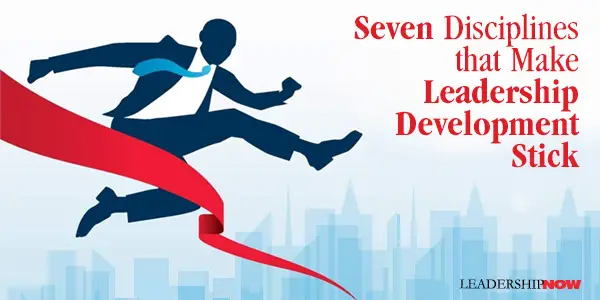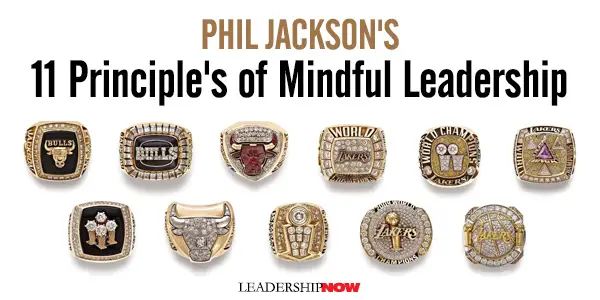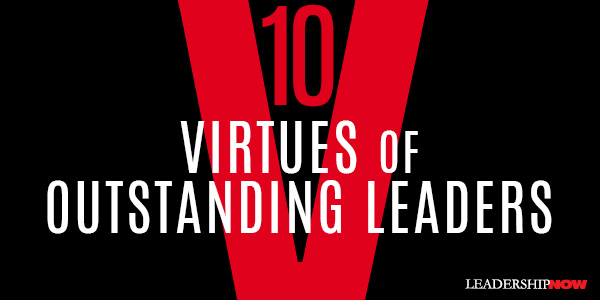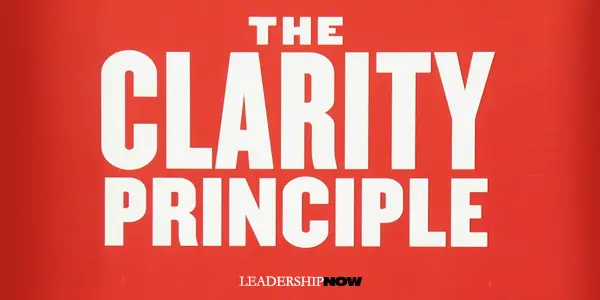 Leading Blog | Posts by Month |
 Leading Blog | Posts by Month |
06.30.13

LeadershipNow 140: June 2013 Compilation
See more on
Posted by Michael McKinney at 09:38 AM
06.28.13

Want to be an Entrepreneur? The Pumpkin Plan
SERIAL entrepreneur Mike Michalowicz, has turned a prescription for growing giant pumpkins in to a formula for building a great business. He calls it The Pumpkin Plan: Step One: Plant promising seeds. Identify and leverage your biggest natural strengths. Step Two: Water, water, water. Sell, sell, sell. Step Three: As they grow, routinely remove all of the diseased or damaged pumpkins. As your business grows, fire all of your small-time, rotten clients. Step Four: Weed like a mad dog. Not a single green leaf or root is permitted if it isn't a pumpkin plant. Never, ever let distractions—often labeled as new opportunities—take hold. Weed 'em out fast. Step Five: When they grow larger, identify the stronger, faster-growing pumpkins. Then, remove all the less-promising pumpkins. Repeat until you have one pumpkin on each vine. Identify your top clients and remove the rest of your less-promising clients. Step Six: Focus all of your attention on the big pumpkin. Nurture it around the clock like a baby, and guard it like you would your first Mustang convertible. Focus all your attention on your top clients. Nurture and protect them; find out what they want more than anything, and if it's in alignment with what you do best, give it to them. Then, replicate that same service or product for as many of the same types of top clients as possible. Step Seven: Watch it grow. In the last days of the season, this will happen so fast you can actually see it happen. Watch your company grow to a giant size. The Pumpkin Plan is an honest look at what running a business is all about. Read it at any stage of your business life-cycle—especially before, certainly during, but even after (you might have a few ah-ha moments). The principles explained in this book can be implemented in real-time. Michalowicz lays it out clearly, cutting through all of the drama and rationalizations and explains what really needs to be done to grow the giant pumpkin. 
Posted by Michael McKinney at 07:47 PM
06.26.13

Seven Disciplines that Make Leadership Development Stick
LEADERS don't always finish well or finish what they start. Leadership sustainability isn't easy. Given the fact that we all know leaders that haven't finished well, it's surprising how many of us have no plan in place to consciously and specifically improve our leadership abilities. Most of the time we wing it. Leadership sustainability is about the commitment to change and growth that is consistent with shifting requirements, not just individually but for the organization as a whole. In Leadership Sustainability, authors Dave Ulrich and Norm Smallwood have defined seven leadership practices that instill sustainability. It begins with "recognition that what matters most is the impact of the leader's actions on others—not just the actions themselves or the rationale behind them." Yet that's not something that we often feel we have time to consider. Our leadership is experienced in our actions and not our intentions. In brief, the seven disciplines to incorporate into your leadership plan to help make your best intentions stick are: Simplicity. Focus on what matters most. Tells stories with impact. Leadership sustainability requires that we find simplicity in the face of complexity and replace concept clutter with simple resolve. It entails prioritizing on the behaviors that matter most. Time. Manage your calendar to reflect your priorities. Put desired behaviors into your calendar. Employees see what leaders do more than listen to what they say. Leadership sustainability shows up in who we spend time with, what issues we spend time on, where we spend our time, and how we spend our time. Recognize routines and modify as necessary. Accountability. Take personal responsibility for doing what you say you will do and hold others accountable as well. "We see too many leadership points of view that are more rhetorical than resolve, more aspiration than action, and more hopeful than real. Leadership wish lists need to be replaced with leadership vows." Be consistent with personal values and brand. Resources. Leaders dedicate resources in order to support their desired changes with coaching and infrastructure. Use a coach. Get coaching and institutional support to become a better leader. "Leaders acting alone, even with great desire and good intentions, are unlikely to sustain their desired changes." Tracking. Move from general to specific measures. Measure what's important and not what's easy. Tie to consequences. Unless desired leadership behaviors and changes are operationalized, quantified, and tracked, they are nice to do, but not likely to be done. Melioration. Leadership sustainability requires that leaders master the principles of learning: to experiment frequently, to reflect always, to become resilient, to face failure, to not be calloused to success, and to improvise continually. Emotion. Know why you lead. Connect change with personal and organizational values. Recognize your impact on others. Celebrate success. "Some leaders work to hide their feelings and avoid becoming too personal with others. These leaders end up distancing and isolating themselves. Leaders who are emotionally vulnerable and transparent will be more likely to sustain change." The authors have provided videos, tools and assessments on their web site to help you to achieve leadership sustainability.

Posted by Michael McKinney at 11:05 PM
06.20.13

Phil Jackson's 11 Principle's of Mindful Leadership
PHIL JACKSON, considered one of the greatest coaches in the history of the National Basketball Association, has won 11 titles as a coach. The most in NBA history. Eleven Rings is a memoir that, for me, is more about leadership and relationships than basketball. Jackson's principles are worth taking a look at. They support the idea that a leader's job is to build leaders at all levels. You could take back to your organization and put into practice today any one of the following 11 principles:1. Lead From the Inside Out. Avoid fads. Lead from who you are. "As time went by, I discovered that the more I spoke from the heart, the more players could hear me and benefit from what I gleaned." 2. Bench the Ego. "The more I tried to exert power directly, the less powerful I became. I learned to dial back my ego and distribute power as widely as possible without surrendering final authority. Paradoxically, this approach strengthened my effectiveness because it freed me to focus on my job as keeper of the team's vision. "Some coaches insist on having the last word, but I always tried to foster an environment in which everyone played a leadership role, from the most unschooled rookie to the veteran superstar. If your primary objective is to bring the team into a state of harmony and oneness, it doesn't make sense for you to rigidly impose your authority." 3. Let Each Player Discover His Own Destiny. Jackson's goal wasn't to provide all of the answers. "I've always been interested in getting players to think for themselves so that they can make difficult decisions in the heat of battle." "My approach was always to relate to each player as a whole person, not just a cog in the basketball machine. That meant pushing him to discover what distinct qualities he could bring to the game beyond taking shots and making passes. How much courage did he have? Or resilience? What about character under fire? Many players I've coached didn't look special on paper, but in the process of creating a role for themselves they grew into formidable champions." 4. The Road to Freedom is a Beautiful System. Similar to the principles used to foster greater creativity and innovation in an organization, Jackson used a system known as the triangle offense. "What attracted me to the triangle was the way it empowers the players, offering each one a vital role to play as well as a high level of creativity within a clear, well-defined structure." 5. Turn the Mundane into the Sacred. Leaders take note. Jackson writes, "As I see it, my job as coach was to make something meaningful out of one of the most mundane activities on the planet: Playing pro basketball." He incorporated meditation into his team's practices. "I wanted to give players something besides X's and O's to focus on. What's more, we often invented rituals of our own to infuse practices with a sense of the sacred." 6. One Breath = One Mind. Players "often have to make split-second decisions under enormous pressure. I discovered that when I had the players sit in silence, breathing together in sync, it helped align them on a nonverbal level far more effectively than words. One breath equals one mind." "If you place too many restrictions on players, they'll spend an inordinate amount of time trying to buck the system. Like all of us, they need a certain degree of structure in their lives, but they also require enough latitude to express themselves creatively." 7. The Key to Success is Compassion. "Now, 'compassion' is not a word often bandied about in locker rooms. But I've found that a few kind, thoughtful words can have a strong transformative effect on relationships, even with the toughest men in the room." Compassion breaks down barriers among people. 8. Keep Your Eye on the Spirit, Not on the Scoreboard. When a player is "playing within his natural abilities, he activates a higher potential for the team that transcends his own limitations and helps his teammates transcend theirs. When this happens, the whole begins to add up to more than the sum of its parts." He adds, "Most coaches get tied up in knots worrying about tactics, but I preferred to focus my attention on whether the players were moving together in a spirited way." 9. Sometimes You Have to Pull Out the Big Stick. Sometimes Jackson used "tricks to wake players up and raise their level of consciousness….Not because I want to make their lives miserable but because I want to prepare them for the inevitable chaos that occurs the minute they step onto a basketball court." 10. When in Doubt, Do Nothing. "Basketball is an action sport, and most people involved in it are high-energy individuals who love to do something—anything—to solve problems. However, there are occasions when the best solution is to do absolutely nothing….I subscribe to the philosophy of the late Satchel Paige, who said, 'Sometimes I sits and thinks, and sometimes I just sits.'" 11. Forget the Ring. We all hate losing. "And yet as coach, I know that being fixated on winning (or more likely, not losing) is counterproductive, especially when it causes you to lose control of your emotions. What's more, obsessing about winning is a loser's game: The most we can hope for is to create the best possible conditions for success, then let go of the outcome." Jackson concludes with: "What matters most is playing the game the right way and having the courage to grow, as human beings as well as basketball players. When you do that, the ring takes care of itself." 
Posted by Michael McKinney at 10:33 AM
06.13.13

The Ten Virtues of Outstanding Leaders
LEADERSHIP and character are inseparable. In the Ten Virtues of Outstanding Leaders, philosophers Al Gini and Ronald Green, ask what is good leadership? They insist "that ethics, character, and virtue are essential to real leadership" and anything else is misleadership. They define leadership as: Leadership is not just a set of learned skills, a series of outcomes, a career, a profession, or a title. Leadership, at its core, is about character: specifically, a character attuned to its ethical responsibilities to others. The kind of character that, in regard to others, always tries to do the right thing, for the right reason, on purpose. They suggest ten virtues or traits of character and as such they describe not just a leader's behavior but a clear sense of the way a leader thinks; the beliefs and motivations behind their actions. They note that these virtues are fragmentary in that they can exist apart from one another and rarely does any leader possess all of them. 1. Deep Honesty. Not just truth-telling but a bias for the truth. "It describes the leader's basic commitment to the truth, and a sense of shame or anger when deceitfulness replaces truth-telling." (James Burke, Johnson & Johnson) 2. Moral Courage. "Here one confronts a multitude of things that terrify people: fear of criticism or embarrassment; fear of poverty or job loss; fear of losing friends or being ostracized—even fear of being seen to be in the wrong. Overcoming self-doubt can be an expression of courage." Courageous leaders hold fast to their values and purpose even when there is no certainty that they will prevail. Courage is of particular importance because unlike the virtue of honesty, is not an aim in itself but it supports other moral claims. As such, philosopher Robert Merrihew Adams describes courage as a "structural virtue." (Abraham Lincoln and Rosa Parks) 3. Moral Vision. Great leaders not only "exhibit moral courage, they are also able to understand the meaning of the values they fight for and the importance of ethics in both human life and in the life of organizations and communities." They understand the consequences of ethical values and are able to share it with others. (Winston Churchill) 4. Compassion and Care. The ability to connect with and resonate to the needs of their followers. Leadership is a relationship. (Oprah Winfrey) 5. Fairness. Leaders should be fair in executing policies across the board. Fairness reinforces followers' trust. Everyone is special but not different. (Dwight D. Eisenhower) 7. Creative Thinking. A tendency toward independence and creativity in thinking. It may show itself "in new ways of accomplishing organizational goals, and even of redefining those goals." In periods of great change a "premium is placed on leaders who can come up with original solutions or approaches." (Herb Kelleher) 8. Aesthetic Sensitivity. This virtue is not just an appreciation of the creation of beauty, but an ability to leverage it for the organizations advantage. "By paying attention to the aesthetic dimensions of their enterprise, outstanding leaders pioneer new products and services and actively shape the tastes of millions." (Steve Jobs) 9. Good Timing. This, like courage, is another structural virtue. It is necessary for the pursuit of any worthy goal. "Like deep honesty, good timing defies superficial outer appraisal. A leader who waits the precise moment to act may appear indecisive to those who urge a quicker response. Such a leader must also have the courage to weather criticisms." (Charles de Gaulle) 10. Deep Selflessness. The willingness to sacrifice oneself. In moments of great organizational uncertainty or crisis, a leader's self-sacrifice "could send a clear message as to what kind of conduct is needed to overcome the crisis and how earnestly the leader is committed to the cause of the organization. It conveys to followers the leader's strong conviction that 'we can do it,' and is an earnest invitation to participate." (Martin Luther King Jr.) In the second part of the book they explore the meaning of each of these virtues through the lives of leaders that lived and exemplified them. "Virtue is learned," write Gini and Green, "by witnessing the deeds of others." 
Posted by Michael McKinney at 11:33 PM
06.10.13

Three Rules to Deliver the Best Possible Performance for as Long as PossibleMichael Raynor and Mumtaz Ahmed went looking for those companies that were good enough for long enough to be considered exceptional and to rule out luck as the primary source of their performance. What they found they present in The Three Rules: How Exceptional Companies Think.When they looked at behavior they found that the exceptional companies did better than the average companies because they did whatever they did "right." Not too helpful. But when they looked at what exceptional companies thought as opposed to what they did, a pattern emerged. They were able to identify a small set of decision rules implicit in the choices exceptional companies made that lower-performing companies did not seem to use. This forms the basis of The Three Rules. Here are the three rules you can use to guide your own decision making: 1. Better Before Cheaper. Competing on non-price value, not price. When it comes to how you differentiate yourself from the competition, seek out a position based on non-price value. Do not compete on price. Price-based competition can work, but only rarely does it drive exceptional performance. When the recession hit in 2008, Abercrombie & Fitch (one of their exceptional companies) was criticized for not cutting their prices as most other retailers did. And although their profitability suffered significantly in the short-term and full recovery remains an uphill climb, they are not struggling to cure their customers of a "discount addiction." "Those competitors that coped with the recession with price discounts are finding it difficult to increase their prices, having taught their customer that their T-shirts do not have to cost $30 after all." Of course, no company can afford to ignore its relative price position. That's why the rule is "better before cheaper:" being price competitive is far from irrelevant, but when it comes to position in a market, exceptional performance is caused more often by greater non-price value rather than by lower price.2. Revenue Before Cost. Outperforming through higher revenue rather than lower costs. When exceptional companies face a trade-off between increasing profitability by increasing revenue or by decreasing cost, they systematically choose increasing revenue even if that means incurring higher cost. Do not try to "cut" your way to greatness. Just like price-based competition, cost advantages can be effective, but only infrequently. Profitability advantages driven by higher revenue, even when they incur higher cost, prove to be more valuable than advantages driven by lower cost. "To beat the odds," say the authors, "you want to focus on creating value using better before cheaper, and on capturing value with revenue before cost." 3. There Are No Other Rules. Whatever competitive or environmental changes or challenges you might face, do not give up on the first two rules. Everything else is up for grabs. Everything. The first two rules tell you what you should do. The third rule tells you what you should not do; namely think that anything else matters in a systematic, specifiable way. Change whatever you must about your business—your markets, your technologies, your people…anything. But no matter what, stick with better before cheaper and revenue before cost. What sort of leadership contributes best to corporate success: charisma, hard-driving, larger than life CEOs who move the company forward seemingly by force of will, or humble, deliberate, share-the-glory servant-leaders? As far as we could tell, all that mattered consistently was whether or not leadership was focused on building a non-price position and revenue-driven profitability formula.The idea here is that when faced with strategic decisions, ask yourself which option best conforms to the three rules. Use the rules like a compass to point you in the right direction. It's not a formula to follow but a way of thinking that informs your decisions. Ask yourself if your strategy is taking you in the direction of better and revenue or cheaper and cost. The authors have found that companies that consistently chose the former path deliver superior results. The three rules are measurable and hence actionable. "Because you can measure the degree to which you are following the three rules, you can adapt your behavior to remain consistent with them." 
Posted by Michael McKinney at 12:02 AM
06.08.13

Try to See Things My Way This short film (1:41) is from actor and storyteller, Jason Headley. It's titled It's Not About The Nail with Monica Barbaro. "Don't try to fix it. I just need you to listen." Every man has heard these words. And they are the law of the land. No matter what.
Posted by Michael McKinney at 09:13 AM
06.06.13

Balance: The Business—Life ConnectionIn Balance, James A. Cusumano reflects on his five careers as the lead singer of a rock band, an Exxon research scientist and executive, a Silicon Valley entrepreneur, a filmmaker and a luxury hotel owner. Through it all he points to people who helped him along the way and pointed him in the right direction. Their perspective helped keep his life in balance.We can all make a unique contribution with the specific set of skills we came into this world with says Cusumano and "there is no greater personal satisfaction on this planet than being in the thick of doing so." To find your passion and purpose, you have to answer four questions: 1. What do I love to do so much so that time passes incredibly quickly? 2. What work do I do or have done in the past that I do not consider work? 3. What could I do that would create the greatest value for the world around me, as well as the greatest personal satisfaction for the amount of time spent? 4. What is my unique ability, the skill or skills which, if truly actualized, could provide significant benefits to the organization for which I work and to me? He believes that 80 percent of his success was based on his early discovery of his fundamental essence—his life purpose—that was fueled by the energy of passion and guided by the "giants" in his life. Passion fuels your creativity and the process provides a deep sense of gratitude and "gratitude always leads to long-term fulfillment and happiness. The greater your sense of gratitude, the greater your level of happiness." Cusumano provides eight principles for building a successful business:

Posted by Michael McKinney at 11:30 PM
06.05.13

The Clarity Principle The Clarity Principle by Chatham Sullivan, is about a widespread issue facing many (most) organizations: who are we and what are we doing? What is our purpose? It is a vitally important question that is rarely answered—not really. It's a difficult question to answer and is the cause of much of the dysfunctional, painful and absurd activity in many organizations. Instead of leading we are being lead by the business we are supposed to be leading.
The Clarity Principle by Chatham Sullivan, is about a widespread issue facing many (most) organizations: who are we and what are we doing? What is our purpose? It is a vitally important question that is rarely answered—not really. It's a difficult question to answer and is the cause of much of the dysfunctional, painful and absurd activity in many organizations. Instead of leading we are being lead by the business we are supposed to be leading.
The Clarity Principle states that clarity is derived from purpose, and purpose from a pivotal act of choice that leaders make about the business. Sullivan says that the problem isn't that organizations define themselves incorrectly, it's that they don't choose at all. Choosing "is a risky prospect, fraught with personal, political, and cultural risks for the organization and its leaders." Leaders often "duck their responsibility for choosing because they cannot accept the tradeoffs, risk, and loss that accompany an act of commitment to choose one definition of the business over the other." A purpose is not necessarily set in stone especially in today's business climate. "Companies do and should reinvent themselves. But there is a big difference between redefining your purpose and attempting to stitch together conflicting business models." He adds, "attempting to simultaneously preserve and replace the core is very likely a fool's errand. There is only so much artful balancing a company can endure. The goal of achieving balance between contradictory models often becomes the biggest excuse for failing to make the bigger choice." We may avoid the choice out of a desire to protect the organization and its people—to maintain a perceived stability and collegiality. To address one choice over the other would disrupt the way in which people have become used to operating. But in the long run, this silence will end up hurting the organization. Sullivan writes that "Leadership's primary responsibility is to define the purpose of the business. This means understanding and making choices to resolve strategic dilemmas confronting the organization." We see dysfunctions in the business not merely as "people problems" but as upwelling expressions of larger foundational business dilemmas. Thus what may at first appear to be a turf battle between two departments is really descended from a persistent failure to clarify the company's purpose or a painful fight with a coworker is less a personal failure or conflict of styles than evidence of an important strategic dilemma.Corporate life so often disappoints writes Sullivan, because "the loss of shared purpose makes the experience of business feel as though it's every man or woman for him- or herself. People who feel disconnected from the primary task of the business become isolated from one another." Sullivan provides numerous examples of conversations that have gone on inside companies in search of their purpose. Their struggles can be quite enlightening and helpful in determining our own. What if you're not the CEO? Take responsibility for those things within your ability to control. Acts of small leadership can thus have outsized impact. They perform the role of making monumental undertakings more easily achievable. In truth, you don't have to be a top executive to resist, confront, and even reverse the contagious effects of a crisis. If the conflicts in the business can flow down from on high, generating breakdowns throughout the organization, so too can creative solutions and purposeful action flow upward to help resolve the crisis. What you can do:
The issues addressed in this book will resonate with most of us. "The battle against ambiguity is never-ending," says Sullivan. Choice defines and establishes that some things are more crucial than others. It's the leader's job.

Posted by Michael McKinney at 11:36 PM
06.01.13

First Look: Leadership Books for June 2013Here's a look at some of the best leadership books to be released in June.




For bulk orders call 1-800-423-8273  Build your leadership library with these specials on over 120 titles. All titles are at least 40% off the list price and are available only in limited quantities. “What is reading but silent conversation?” — Walter Savage Landor
Posted by Michael McKinney at 10:05 AM
|
BUILD YOUR KNOWLEDGE


How to Do Your Start-Up Right STRAIGHT TALK FOR START-UPS 
Grow Your Leadership Skills NEW AND UPCOMING LEADERSHIP BOOKS 
Leadership Minute BITE-SIZE CONCEPTS YOU CAN CHEW ON 
Classic Leadership Books BOOKS TO READ BEFORE YOU LEAD |
|